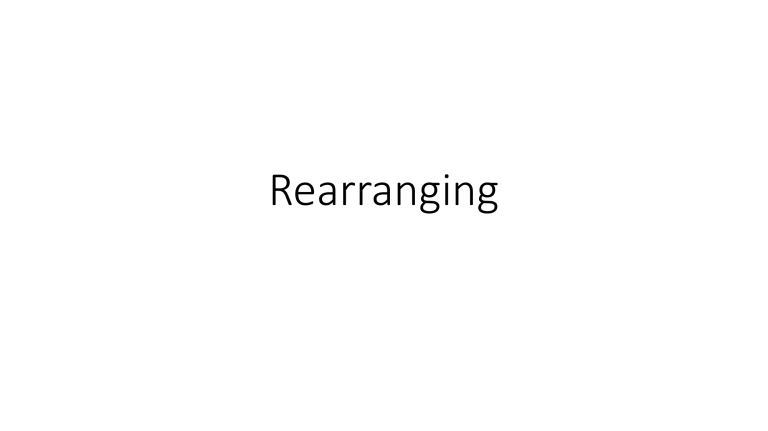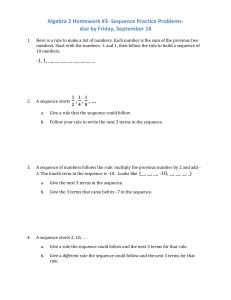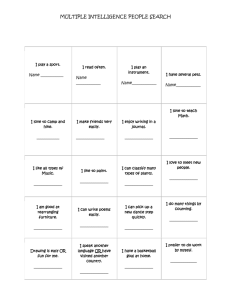
Rearranging Side Note of Writing Algebra • a + a + a + a can be written as 4a • Y x Y can be written as Y2 • A x Y can be written as AY • 3A ÷ 2Y can be written as 3𝐴 2𝑌 Why do we rearrange? • Rearranging is a fundamental part of mathematics • From GCSE onwards algebra becomes the ‘bread and butter’ of almost all maths problems. • Almost all problems you will now solve will require some degree of manipulation of an equation to either: • Solve for ‘x’ • Write the answer in the form the question wants (y=mx+c) • Make the equation look ‘nicer’ and easier to learn things from: • Can’t learn much from the equation y=X2+2x+1 – but written in the form y=(x+1)2 we can figure out how to plot its graph, where it crosses the axes and its minimum point. Main aim of rearranging • Equations show how one variable can be related to another. • For example: y = 6x shows that for a given value of ‘x’ the corresponding value of ‘y’ will be 6 times greater than it. • However, what if we wanted to see how ‘x’ is related to y instead? Now we have to rearrange - In this case for a given value of ‘y’ the 𝑦 corresponding value of ‘x’ will be 6 times smaller than it = 𝑥 6 • This become even more apparent when we apply algebra to the realworld? John has bought some 54 shelves from IKEA to make a library in his home. If each bookcase will contain 6 shelves how many bookcases can he make? • Let assign algebra to the two variable in this equation: For bookcases we will use B and for Shelves we will use S. • If there are 6 shelves per bookcase then we get: 𝐵 = 𝑆/6 • This now describes the relationship between how many shelves are needed for each bookshelf. Therefore if John has 54 shelves we can make: 54 𝐵 = = 9 𝑏𝑜𝑜𝑘𝑠ℎ𝑒𝑙𝑣𝑒𝑠 6 But John already has the frame for 12 bookshelves, so how many shelves did he actually need? • We already how shelves are related to bookcases (𝐵 = 𝑆 ) 6 • By rearranging we can figure out how bookcases are related to shelves: 𝑀𝑢𝑙𝑡𝑖𝑝𝑙𝑦 𝑏𝑜𝑡ℎ 𝑠𝑖𝑑𝑒𝑠 𝑏𝑦 6: 𝑆 6 ∗ 𝐵=6 ∗ 6 6𝐵 = S • So if we have 12 Bookshelves: S = 6 x 12 = 72 shelves The main aim of this session is to help you make the variable you want to find the subject of an equations. Rearranging – Addition and Subtraction • In essence, we want to get the desired variable to be on it own on one side of the equals sign; with all other numbers and letter on the other side. • Think of the equal sign as the balanced scale, the Left Hand Side (LHS) and the Right Hand Side (RHS) must be equal. Thus: WHATEVER YOU DO TO ONE SIDE OF THE EQUATIONS YOU MUST DO TO THE OTHER!!! • So if I have the equation y = x + 6 and I wanted to ‘x’ • If I have add 6 on the right and I want ‘x’ on its own I must -6 from both sides: y-6=x+6–6 y–6=x • Another more intuitive way of thinking of rearranging is ‘moving’ things across an equals sign. • If I has the equation a – 17 = b and I wanted to make ‘a’ the subject I could ‘move’ the -17 to the other side. WHENEVER YOU MOVE SOMETHING ACROSS THE EQUALS SIGN YOU MUST SWAP ITS SIGN TO THE INVERSE OPERATOR • So If we move -17 to the RHS of the equation, we make it +17. Thus, the equation is a = b + 17. • Both ways work to solve algebra. I recommend you remember both. ‘Moving’ numbers makes more sense in some cases, but in other cases it is easier to think about adding/subtracting from both sides. General Rule for Rearranging 1. Move the desired variables all onto one side – making sure it is positive. 2. Move all unwanted variables to the other side. Questions – Rearranging – Addition and Subtraction • Make F the subject: • V = F – 30 + 55 • Make Q the subject: • Q – 34 = P + 29 • Make Z the subject: • X-Y=V+W–Z Answers • F = V – 25 • Q = P + 63 •Z=V+W–X+Y Rearranging – Multiplication and Division The same rules apply when we are multiplying and dividing: 6y – 18 = 12x – rearrange for y Add 18 to both sides: 6𝑦 − 18 + 18 = 12𝑥 + 18 Divide both sides by 6: 1 1 ∗ 6𝑦 = 12𝑥 + 18 6 6 𝑦= 12 18 𝑥+ = 2𝑥 + 1 6 6 Example: find f in the equation 𝟐𝒈 + 𝟏 𝒉 𝟐 = 𝟏 𝒇 𝟖 − 𝟒 𝒌 𝟔 While this may look difficult at first, it can be solved with all the principles we have seen so far. While you could start rearranging first to get ‘f’ on one side, I wanted to highlight that sometimes it is easier to multiply through by a number to get rid of all/some of the fractions. It is not necessary but you may find it easier in some cases: Multiple through by 8: 1 1 4 8 2𝑔 + ℎ = 8 𝑓 − 𝑘 2 8 6 8 8 24 16𝑔 + ℎ = 𝑓 − 𝑘 2 8 6 8 8 24 16𝑔 + ℎ = 𝑓 − 𝑘 2 8 6 16𝑔 + 4ℎ = 𝑓 − 4𝑘 Add 4k to both sides: 16𝑔 + 4ℎ + 4𝑘 = 𝑓 − 4𝑘 + 4𝑘 16𝑔 + 4ℎ + 4𝑘 = 𝑓 You could even take it a step further and factorise to neaten the equation up: 𝑓 = 4(4𝑔 + ℎ + 𝑘) General Rule for Rearranging – Revisited 1. Move the desired variables all onto one side – making sure it is positive. 2. Move all unwanted variables to the other side. 3. Multiply and/or Divide through by the coefficient on the desired variable. More Difficult Questions • Find a: • 8a + b – 12 = 48c -21b – 6a • Find r: • 14 𝑠 4 + 21 𝑝 8 7 8 + 56 = r Answers a = 24c – 10b + 6 14 21 7 𝑠+ 𝑝 + 56 = 𝑟 4 8 8 Divide through by 7: 1 14 21 1 7 𝑠 + 𝑝 + 56 = ∗ 𝑟 7 4 8 7 8 1 3 1 𝑠+ 𝑝+8 = 𝑟 2 8 8 Multiply through 8: 1 3 1 8 𝑠+ 𝑝+8 =8∗ r 2 8 8 𝑟 = 4s + 3p +64 Questions: • Solve for q: • -4q = 8t – 9s + 2n • Solve for a: 2 3 • 𝑏 − 5𝑐 − 𝑎 = 10𝑐 + 𝑎 − 2𝑏 5 5 • Hint: you want all the ‘a’ on one side and to be positive • Solve for y: 4 3 1 3 • 10𝑥 + 𝑦 − 15 = 25𝑥 − 𝑦 + 5 −4𝑞 = 8𝑡 − 9𝑠 + 2𝑛 Divide by -4: −4 1 𝑞 = − 8t − 9s + 2n −4 4 8 9 2 𝑞=− 𝑡+ 𝑠 − 𝑛 4 4 4 9 1 𝑞 = −2𝑡 + 𝑠 − 𝑛 4 2 2 3 𝑏 − 5𝑐 − 𝑎 = 10𝑐 + 𝑎 − 2𝑏 5 5 2 5 Add 𝑎 to both sides: 2 2 3 2 𝑏 − 5𝑐 − 𝑎 + 𝑎 = 10𝑐 + 𝑎 + 𝑎 − 2𝑏 5 5 5 5 𝑏 − 5𝑐 = 10𝑐 + 𝑎 − 2𝑏 Subtract 10c from both sides: 𝑏 − 5𝑐 − 10𝑐 = 10𝑐 − 10𝑐 + 𝑎 − 2𝑏 𝑏 − 15𝑐 = 𝑎 − 2𝑏 Finally add 2b to both sides: 𝑏 + 2𝑏 − 15c = a − 2b + 2b 𝑎 = 3𝑏 − 15𝑐 4 1 10𝑥 + 𝑦 − 15 = 25𝑥 − 𝑦 + 5 3 3 1 Add 𝑦 to both sides: 3 4 1 1 1 10𝑥 + 𝑦 + 𝑦 − 15 = 25𝑥 − 𝑦 + 𝑦 + 5 3 3 3 3 5 10𝑥 + 𝑦 − 15 = 25𝑥 + 5 3 Add 15 to both sides: 5 10𝑥 + 𝑦 − 15 + 15 = 25𝑥 + 5 + 15 3 5 10𝑥 + 𝑦 = 25𝑥 + 20 3 Minus 10x from both sides… 5 10𝑥 − 10𝑥 + 𝑦 = 25𝑥 − 10𝑥 + 20 3 5 𝑦 = 15𝑥 + 20 3 Multiply through by 3/5: 3 5 3 ∗ 𝑦 = (15𝑥 + 20) 5 3 5 15 20 𝑦=3 𝑥+ = 3 3𝑥 + 4 5 5 𝑦 = 9𝑥 + 12 Challenge questions • Find x: • 2 3𝑥 − 4 6𝑥 = −8 • Find d: 𝑎 𝑑 𝑏 + 2 • = 5𝑐 • Hint: you may need to factorise at some point!



